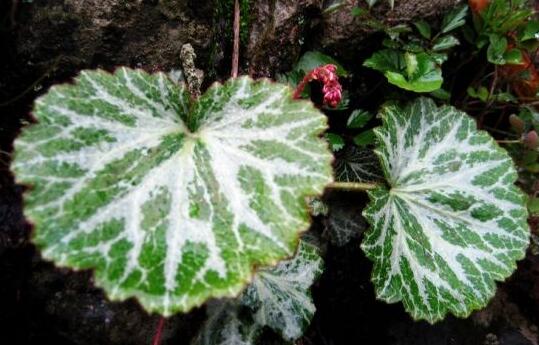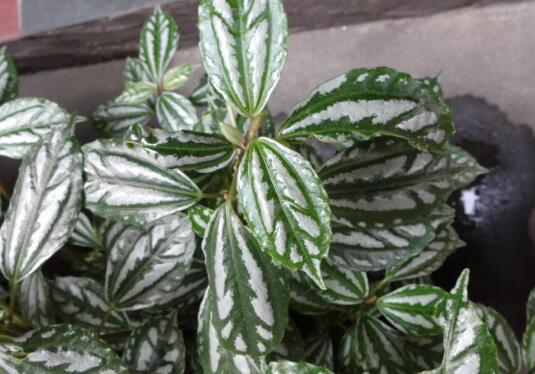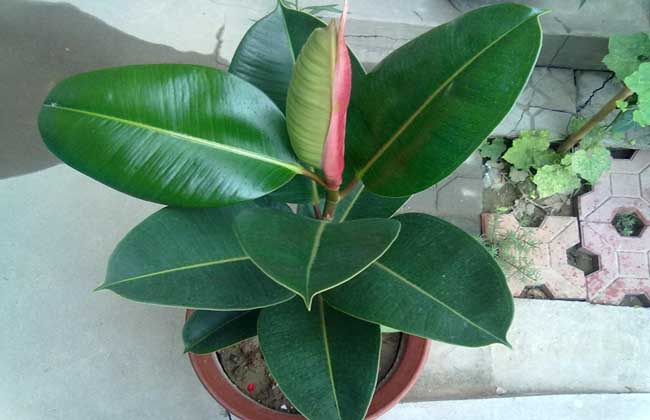How to grow Saxifraga
How to plant Saxifraga? Saxifraga belongs to Saxifragaceae. Saxifraga is a perennial herb, native to the south of Qinling Mountains in China, with green leaves, white reticular veins, purplish red on the back, white hairs on both sides, similar to Saxifraga, hence the name Saxifraga. Petiole is long, mostly purplish red. Flowers to summer, panicles, irregular white flowers, with two very long petals, sparse flowers. Among the cultivated varieties, there is another kind of Saxifraga tricolor. The broad edges of white or milky white leaves are inlaid with red, yellow and white patches. The petiole is short, exquisite and elegant, so it is suitable for small pot cultivation.
Saxifraga plant is small, the leaf shape is strange, like the shady and wet environment, so do more water-absorbing stone bonsai decoration, rock garden planting materials, can also be cultivated in ponds, wells, streams next to shady places. Families do more potted plants, hanging upside down under the eaves or indoor appreciation, giving people a fresh and elegant, vibrant feeling.
When each leaf of Saxifraga grows to a certain point, it will protrude a slender stem from the axil of the leaf, which is initially translucent and quite tender. As the leaves grow, the stem and leaves grow longer and longer, then sprout nodes on the stem, hang out a blossoming small Saxifraga, and hang it indoors with a unique elegant demeanor.
Saxifraga is shady-tolerant, and attention should be paid to the selection of shady and wet places for cultivation and suspension. Potted plants should use humus or peat soil and fine sandy soil, which requires loose texture and good drainage. Pour the pot and change the soil every spring or after flowering. Growth must have a higher air humidity, but the basin soil should not be waterlogged. After flowering, there is a period of dormancy, moisture must be properly controlled, too wet roots are easy to rot. Rarefied liquid fertilizer was applied every two weeks in spring and autumn, and fertilizer was stopped in dormant period and winter. Saxifraga is more hardy and generally does not suffer frost damage. In the northern region, potted plants should survive the winter indoors at no less than 15 ℃, but Saxifraga tricolor has poor cold tolerance and the overwintering temperature should not be lower than 15 ℃.
Planting method of Saxifraga
Flower bonsai net flower maintenance column: the planting method of Saxifraga will introduce to you the cultivation method of Saxifraga, how is Saxifraga good?
(1) Overview of Saxifraga
Also known as Saxifraga, Saxifragaceae perennial herbs. It is 14 cm high and produces creeping stems of varying lengths at the base of the plant, 80 cm 100 cm in length, and one to several plantlets at the top of the stem. In the pot, the small plants and creeping stems hang around the pot, which is very interesting and beautiful. Leaves several, basal, subreniform, green above, with wide A-color reticulate veins, abaxially densely covered with purplish red dots, and long hairs on both sides. Panicle, sparse flowers, irregular white florets, 2 petals long. The cultivated variety does not have "tricolor" Saxifraga, the leaves have white or milky broad edges and embedded with red, yellow and inner color patches, and the leaves are shorter, so they are suitable for potted plants.
(2) main points of cultivation of Saxifraga
Temperature: like a cool environment, the lowest overwintering temperature is 5 ~ 7 degrees Celsius, the overwintering temperature of Saxifraga tricolor should be about 16 degrees Celsius. S should be placed in a cool and ventilated place and dormant at high temperature.
Light: like bright light, avoid strong sunlight, shade about 50% in summer.
Moisture: watering basin soil surface when 1cm to 2cm dry, not too wet, avoid basin soil stagnant water. Watering should be reduced when the winter temperature is too low or the summer humidity is too high.
Air humidity: can often spray water to the leaf surface and around the plant.
Change the basin: change the basin every spring.
Reproduction: the potted plants on the stolons are easy to survive.
How to reproduce Saxifraga, the propagation methods / ramet and sowing essentials of Saxifraga
Saxifraga has beautiful leaves and gorgeous flowers, so many people want to raise more pots, but they don't know how to reproduce Saxifraga. At present, the two common breeding methods of Saxifraga by botanists are ramet and sowing, each of which has its own advantages and disadvantages. So you need to choose according to your own situation.
How does Saxifraga reproduce

The most commonly used way of plant reproduction is cutting, sowing and ramet, so how to propagate Saxifraga is the best. Both ramet and sowing can be used. As the two methods have their own different characteristics, here is a comparison of their advantages and disadvantages.
Ramet propagation: the advantage is that the success rate is high, the effective time is short, and the operation is simple; the disadvantage is that the breeding time is limited.
Sowing and reproduction: the advantage is that it is easy to maintain; the disadvantage is that the seeds are not easy to collect and the selection of seeds needs to be careful.
Propagation methods of Saxifraga
1. Separate propagation of Saxifraga
1. Breeding time
If the conditions are right, they can reproduce all year round, but most people can't provide the right environment at any time, so for ordinary people, ramet reproduction should be carried out in spring or autumn, when the temperature is not high.
2. Operation steps
A, select branches
In April or October, select the sturdy plantlets on the stolons of Saxifraga and cut them off.
B, plant branches
Plant the branches in the culture pot, then cover with glass or plastic film, observe the humidity inside every day, be sure to ensure a high humidity.
C, transplanting
About two weeks after ramet propagation, the plant can resume growth, and at this time it can be transplanted to other places, such as pots or under the eaves.
2. Sowing and propagation of Saxifraga
If you have the opportunity to obtain Saxifraga seeds, then this Saxifraga reproduction method is the most worthy of choice, but when sowing reproduction, there are three points to pay attention to:
1. Choose the soil carefully.
Saxifraga requires soil to be fertile, moist and well drained. It can be planted under a dense, wet forest, or on a cool, damp hillside, so as not to be exposed to direct sunlight.
2. Timing is very important
Using sowing propagation, the best time is from March to April, when the humidity and temperature are more suitable, and grow faster after emergence, from sowing to emergence, it generally takes about 15-20 days.
3. Late maintenance
The new seedlings that grow after sowing are relatively fragile, so it is necessary to understand the correct breeding methods and points for attention of Saxifraga. The new seedlings do not need to be watered many times after transplanting, but in order to keep the basin soil moist, they should be shaded in summer, with a shade degree of 50-60%.
Conclusion: the reproduction methods of Saxifraga are mainly ramet and sowing, because the seeds are not easy to collect, so most people use ramet propagation, and no matter which breeding method is used, it must be emphasized that the environment should be suitable. The environment includes temperature, humidity, and light, which is suitable in a humid and cool environment, and the maintenance in the later stage is equally important.
- Prev

How to raise a cold spray
How to raise cold water, cold water, also known as snow grass, flower and leaf nettle, is a perennial herb of Urticaceae. Its underground rhizome is horizontal, the plant height is 30cm to 50cm, the aboveground stem is fleshy and translucent, the internodes are dilated and much branched. Leaves opposite, egg-shaped, leaf tip pointed, three main veins are very obvious
- Next

How to raise potted rubber trees
How to raise potted rubber trees, rubber trees have broad and thick leaves, bright leathery, evergreen all the year round, and are good potted foliage plants. (1) the regulation of light. Rubber trees like light and need more than medium intensity of light, but avoid direct sunlight in summer to avoid leaf burns.
Related
- Fuxing push coffee new agricultural production and marketing class: lack of small-scale processing plants
- Jujube rice field leisure farm deep ploughing Yilan for five years to create a space for organic food and play
- Nongyu Farm-A trial of organic papaya for brave women with advanced technology
- Four points for attention in the prevention and control of diseases and insect pests of edible fungi
- How to add nutrient solution to Edible Fungi
- Is there any good way to control edible fungus mites?
- Open Inoculation Technology of Edible Fungi
- Is there any clever way to use fertilizer for edible fungus in winter?
- What agents are used to kill the pathogens of edible fungi in the mushroom shed?
- Rapid drying of Edible Fungi

